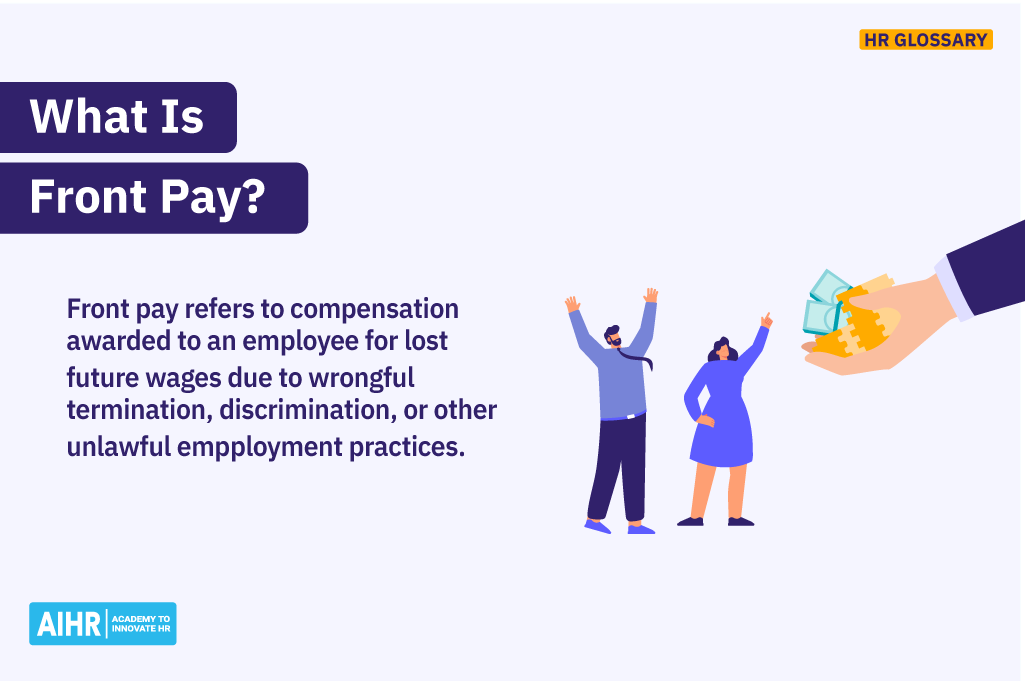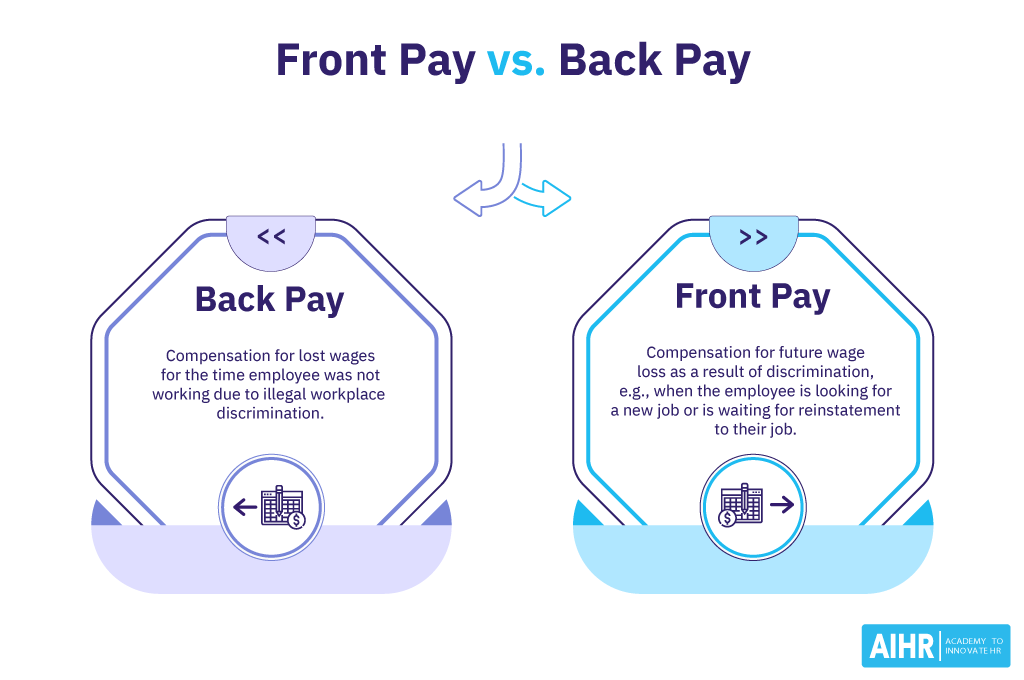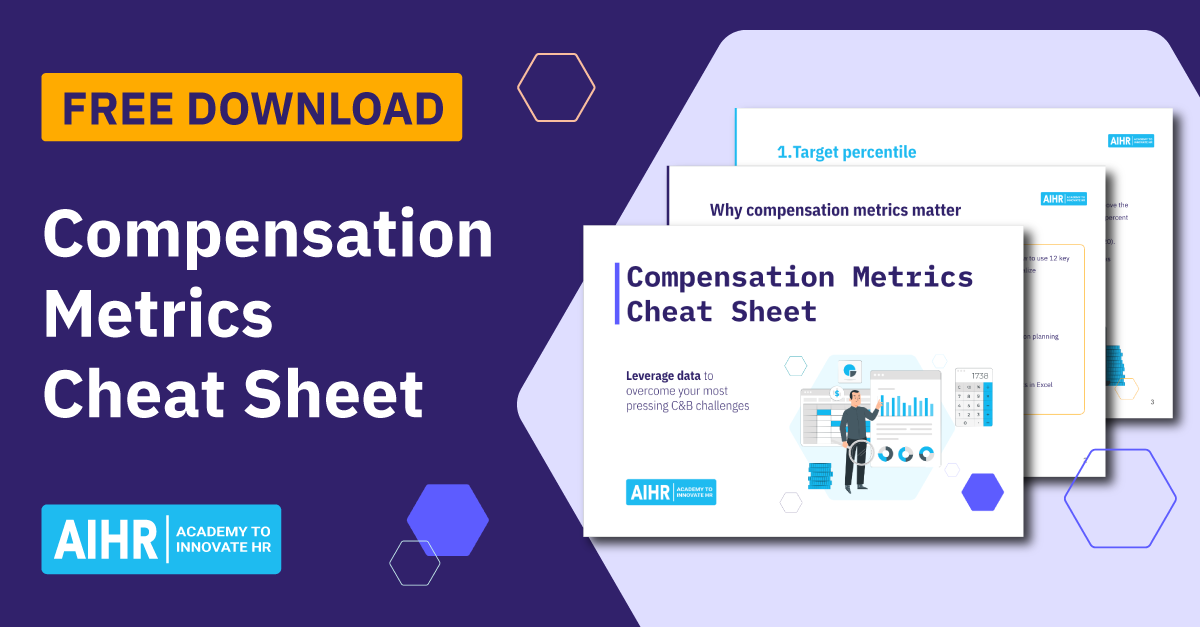Front Pay
What is front pay?
Front pay is compensation provided to an employee who has been unlawfully terminated or affected by workplace discrimination. It is designed to cover the income they would have earned if they had continued in their role. This type of payment is typically awarded in legal cases where returning the employee to their original position isn’t practical due to circumstances such as workplace hostility or organizational restructuring.
The amount is calculated based on factors like the employee’s expected future earnings, benefits, and how long it might reasonably take them to secure a comparable job. Front pay helps to bridge the financial gap and provides employees with economic stability while they search for or transition to new employment.

Front pay examples
Here are some examples of situations where front pay might be awarded:
- Wrongful termination due to discrimination: An employee unlawfully terminated due to gender, race, or age wins their case. Reinstatement isn’t viable because it would expose them to a hostile work environment. Instead, they are compensated for the income they would have earned while seeking similar employment.
- Position elimination after retaliation: Let’s say an employee is terminated for reporting workplace harassment, and it’s revealed during the lawsuit that their position has been eliminated. Since reinstatement is no longer possible, the court awards front pay to compensate for the income they would have earned in that role had it not been eliminated.
- Employer’s refusal to reinstate: A whistleblower wins their case, and the court orders reinstatement, but the employer declines, citing irreparable trust issues. To make up for this, the employee is compensated for the earnings they would have received if reinstated.
- Organizational restructuring: An employee terminated for discriminatory reasons discovers during litigation that their team was disbanded as part of a company restructuring. Since returning to the job is impossible, they are awarded payment for lost future wages.
- Diminished career prospects: A senior executive who was unlawfully terminated faces challenges finding a comparable role in the same industry due to the nature of their dismissal. The court awards front pay to account for the time needed to transition to a new position or industry.
Front pay vs. back pay
The key difference between front pay and back pay lies in the time period they cover in employment-related legal cases:
- Front pay is forward-looking compensation awarded for lost future earnings when reinstating an employee is not feasible. It accounts for wages, benefits, and other earnings the employee would have received moving forward if they had remained employed and is typically awarded after a case is resolved.
- Back pay compensates for past earnings lost due to wrongful termination, discrimination, or other unlawful actions. It covers the period from the date of the employer’s violation up until the resolution of the case or the employee’s reinstatement.
In short, back pay addresses financial losses that occurred before the case was resolved, while front pay provides financial security for the period after resolution when future employment prospects are uncertain.

Does front pay lead to reinstatement?
No. Reinstatement assumes that the employee will resume their previous position without compensation for the losses incurred. Front pay is paid when reinstatement is not possible, either because the role has already been filled or because the position is no longer available. When reinstatement is possible, front pay may still be awarded to compensate for any losses incurred.
How do you calculate front pay?
Calculating front pay involves estimating the earnings an employee would have received in the future if they had remained employed. While the exact method varies depending on the case, the following factors typically guide the calculation:
- Length of time for front pay: Courts estimate the reasonable period it would take the employee to find comparable employment. This depends on factors like the individual’s skills, industry demand, and economic conditions.
- Base salary: The employee’s annual salary at the time of termination serves as the starting point for calculating front pay.
- Lost benefits: The value of benefits, such as health insurance, retirement contributions, bonuses, and stock options, is included in the calculation.
- Adjustments for raises or promotions: Courts may consider expected raises, promotions, or career advancement the employee would likely have achieved if they stayed in the role.
- Mitigation of damages: Employees are typically expected to mitigate their losses by seeking comparable employment. The potential earnings from such a role are subtracted from the total front pay award.
- Discount for present value: Because front pay compensates for future earnings, the award is often discounted to reflect its present value, accounting for inflation and investment returns.
A simplified formula for front pay would be as follows:
| Front pay = | (Annual salary + Benefits) × Estimated employment gap (years) − Potential future earnings |
Calculation example
An employee earning $70,000 annually with $15,000 in benefits is terminated unlawfully. The court estimates it will take them two years to find comparable employment, but they are expected to earn $50,000 annually in a transitional role during this time.
- Total lost earnings: ($70,000 + $15,000) × 2 = $170,000
- Subtract potential earnings: $170,000 − ($50,000 × 2) = $70,000
The front pay award, in this case, would be $70,000, adjusted for present value.
HR tip
When calculating front pay, focus on factors like the employee’s lost wages, benefits, and the time needed to find comparable work. Encourage employees to actively seek new opportunities to mitigate damages, as courts often adjust awards based on these efforts. Clear documentation of losses and job-seeking activities strengthens your case in disputes.
What are the limits on front pay?
The limits on front pay depend on various factors, including the specific case, legal statutes, and jurisdiction. Here’s a breakdown of how it generally works:
- Case-specific limits: Courts or administrative bodies determine these awards based on the circumstances. They’re usually granted when reinstatement isn’t feasible, such as in a hostile work environment or if the position no longer exists. The duration covered depends on how long it would reasonably take the individual to find comparable employment, varying case by case.
- Mitigation of damages: The amount of front pay may be reduced if the employee fails to make reasonable efforts to find new employment. Plaintiffs are generally required to mitigate their damages by actively seeking comparable jobs.
- Statutory caps: Some federal laws, such as Title VII of the Civil Rights Act of 1964, impose caps on compensatory damages, which may include front pay in some cases. The cap depends on the size of the employer:
- $50,000 for employers with 15 to 100 employees
- $100,000 for employers with 101 to 200 employees
- $200,000 for employers with 201 to 500 employees
- $300,000 for employers with more than 500 employees.
- State laws: Some states have their own laws governing employment discrimination and wrongful termination, which may impose additional or differing limits on front pay.
- Settlements: In settlements, the amount of front pay is often negotiated and may not align with statutory limits since both parties must agree to the terms.
- Tax implications: These payments are considered taxable income, potentially influencing the final amount awarded or agreed upon in negotiations.
- Nature of employment: The calculation often takes into account the employee’s salary, benefits, and anticipated raises, but it does not typically include speculative bonuses or promotions.
FAQ
Front pay is compensation awarded to an employee for future lost earnings when reinstatement after wrongful termination or discrimination isn’t possible.
Front pay is awarded when reinstatement isn’t feasible due to factors like a hostile work environment, position elimination, or organizational changes.
Front pay compensates for future lost earnings, including wages and benefits, that an employee would have earned if they had remained in their role.









